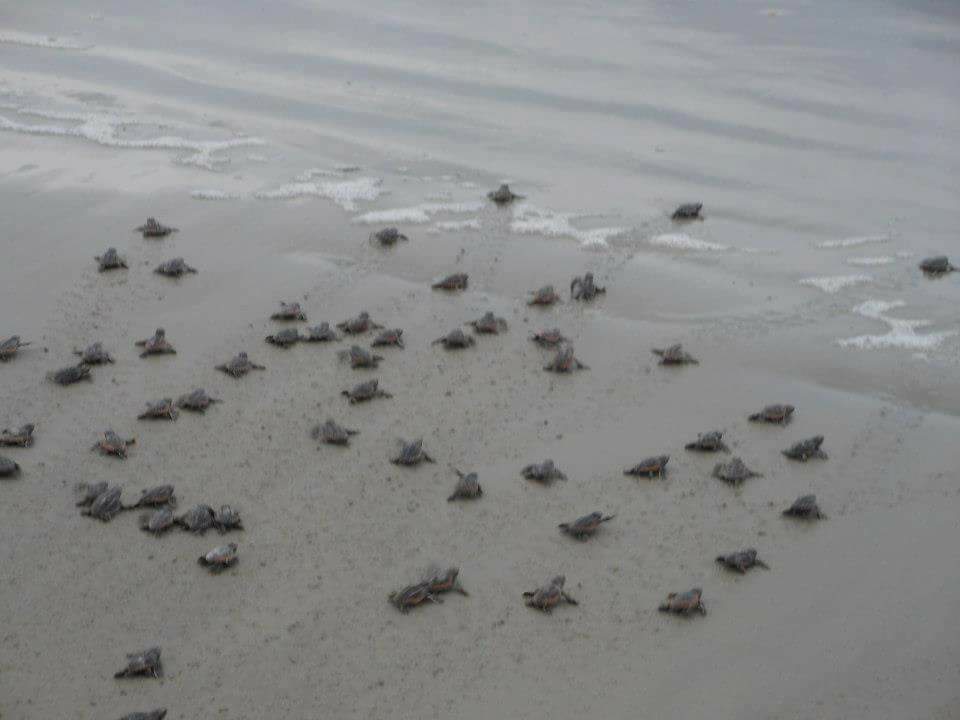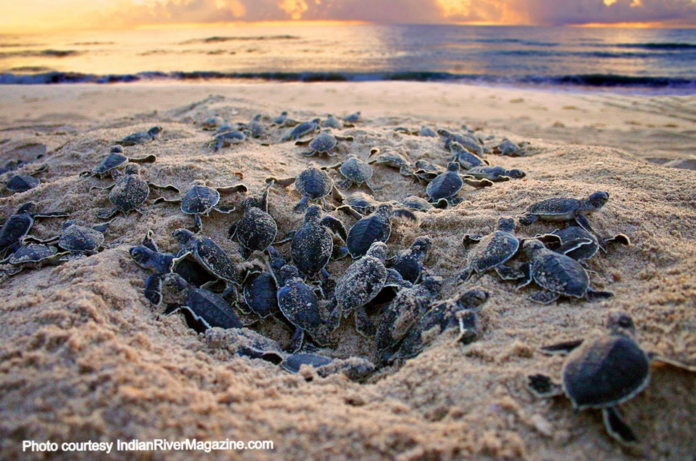If you’ve had the good fortune to witness a Lowcountry turtle boil, you know it has absolutely nothing to do with cooking or eating turtles. I’m talking about the nearly simultaneous hatching of a hundred or more baby sea turtles on a moonlit Sea Island beach. And it’s about to happen again!
On Hilton Head Island [and all of Beaufort’s sea islands], mama loggerhead sea turtles lay several hundred nests every year, May through July, then immediately return to the ocean. Left on their own, the eggs incubate in the warm sand for about 45-60 days. That means that those babies are just about ready to hatch and begin their dangerous journey to the ocean. Known as a “turtle boil” because the hatching nest resembles a pot of boiling water, this amazing event generally happens well past dark when sea birds are less likely to catch the babies on their instinctive race to the breaking waves. It’s not an easy journey for the newborns, but somehow they know they must enter the world in a rush if they want to survive for even a short time. Even so, only 1 in 1,000 sea turtle hatchlings make it to adulthood.
“A fiery red glow illuminated the pit of sand at the boy’s feet, sand that was now churning as if alive. A black shape emerged from the eruption, followed by another, and then another. Delta squealed and jumped back as suddenly dozens of dark creatures emerged from the spot that, just a moment ago, had been as still and smooth as any other dune on the island beach.” — THE SEA TURTLE’S CURSE, by Susan Diamond Riley (Koehler Books, 2021)
A Surreal Experience
I’ll never forget the first time I witnessed this incredible act of nature. My daughters and I had joined another family on the beach near our island home late one August night in the hopes of catching a nest in boil. We knew that numerous other nests had already hatched, so the chances were good that one might boil that night. But dozens of nests lined the stretch of beach at our north end of the island. The odds weren’t great that we’d be standing by the right one. Our group had spread itself down the dunes, guarding several nests that we believed were due to hatch, when we heard a shout from one of our clan. The sand covering one of the protected nests, carefully surrounded by caution tape, had collapsed–a sure sign that a boil was imminent. Armed with our turtle-safe red flashlights, we all ran to watch the excitement ahead.

After about a five-minute wait (which felt like an eternity), the first tiny turtle poked its nose through the sand. Using its flippers, it purposefully pulled itself to the surface. Careful not to touch the creature, we admired its immediate instinct to head toward the ocean. But then the real “boiling” began. Suddenly, the sand churned wildly as a seemingly endless flow of babies emerged from the sand and rushed (yes, rushed!) toward the sea. We all stood perfectly still, afraid that we might step on a crawling turtle if we took even a step in any direction. The beach surrounding us was covered in hatchlings who, despite their comically flopping flippers, moved surprisingly quickly. Within fifteen minutes of sighting that first little turtle nose, we watched the final baby enter the ocean and swim toward the Gulf stream. We had counted 120 hatchlings.
Keep Those Babies Safe!
If you wish to see a Lowcountry turtle boil, remember that the hatchlings’ safety is of utmost importance. To ensure that your presence does not hinder their progress to the ocean, here are a few general rules to follow:
-
Fill all holes, flatten all sandcastles, and remove all personal gear after a day on the beach. These can all block a baby turtle’s path to the water, sometimes trapping them completely.
-
Keep lights off near the beach at night so hatchlings (and their egg-laying mamas) don’t head inland by mistake instead of toward the moonlight over the ocean.
-
If you must have a personal light on the beach at night, use only RED light (which does not distract the turtles). You can convert a regular flashlight to red by covering the lens with red cellophane. Some cell phone apps also allow you to shine a red light from your phone
-
NEVER TOUCH A SEA TURTLE! Loggerheads (and several other turtle species) are protected by law. It is illegal to tamper with their nests or with the animals themselves. You are there to witness–not touch.
Sea turtles are undoubtedly a gift to the Lowcountry coast. Respect them and their struggle to survive. If you do, you may just be blessed to see these miracles in action.
Watch a sea turtle nest boil on the beach at Hunting Island in the video below.
Originally written as “A Race to the Midnight Moon” by Susan Diamond Riley. Susan has written three popular books; The Sea Islands Secret, The Sea Turtle’s Curse, and The Sea Witches Revenge. You can see more of Susan’s writing and find her books at SusanDiamondRiley.com










